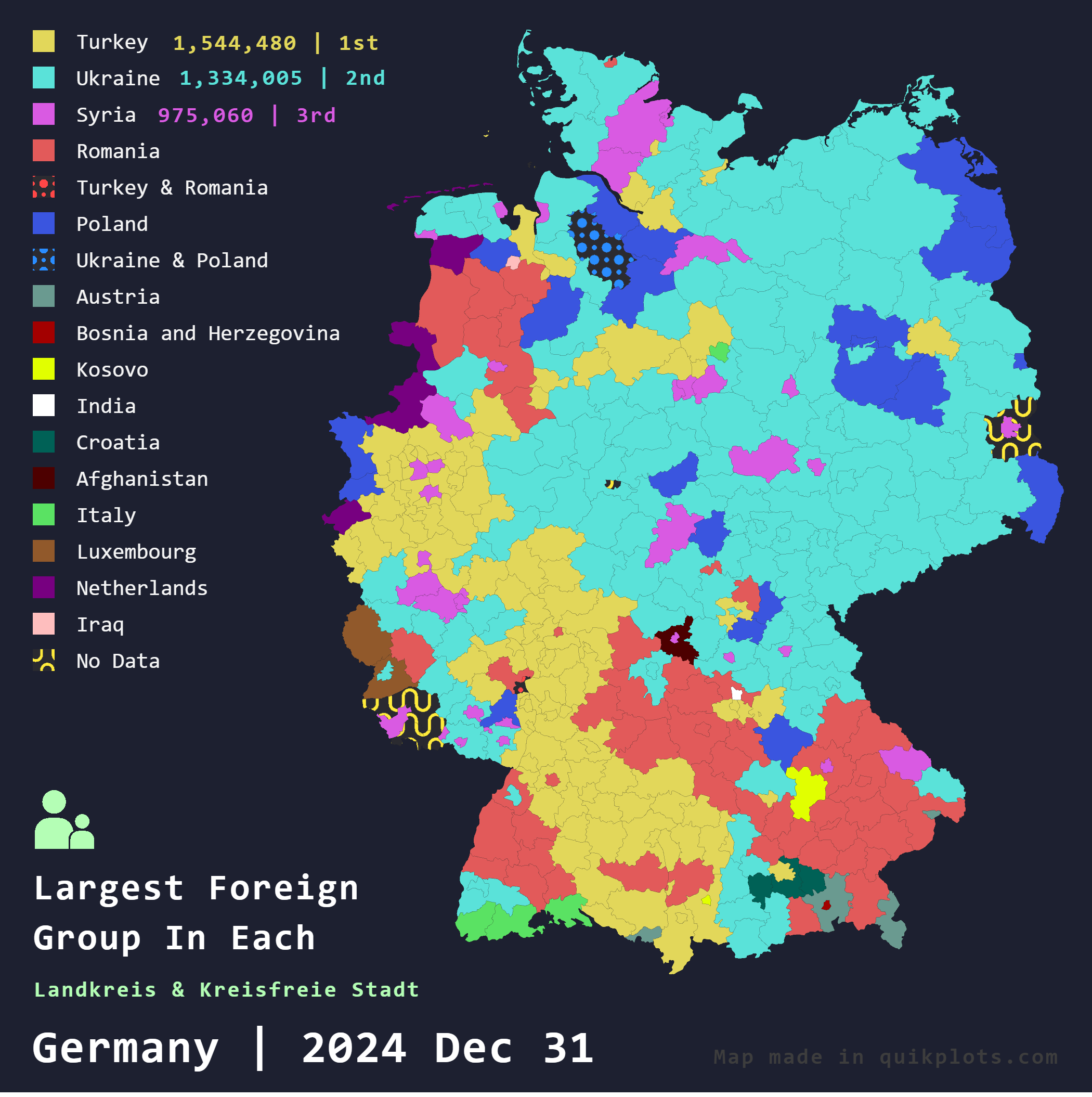Largest Foreign Groups in Germany Map


Alex Cartwright
Senior Cartographer & GIS Specialist
Alex Cartwright is a renowned cartographer and geographic information systems specialist with over 15 years of experience in spatial analysis and data...
Geographic Analysis
What This Map Shows
The "Largest Foreign Groups in Germany Map" provides a comprehensive overview of the foreign population distribution across each Landkreis (district) and Kreisfreie Stadt (independent city) in Germany as of December 31, 2024. It highlights the demographic makeup of these areas by detailing the largest foreign communities, represented by the total male and female populations from various countries. This visualization is based on the latest data from Germany's official statistics body, reflecting the country's rich tapestry of cultural diversity and migration trends.
Deep Dive into Foreign Demographics in Germany
Germany has long been a destination for migrants, contributing to its vibrant multicultural society. The foreign population comprises individuals from a variety of countries, and this map showcases these groups, revealing fascinating insights into demographic patterns. For instance, the largest foreign groups often stem from neighboring countries and regions with historical ties to Germany, such as Turkey, Poland, and Syria.
As of the end of 2024, the data shows that Turkish nationals remain one of the largest foreign groups in Germany, maintaining a significant presence particularly in urban centers like Berlin and Frankfurt. Interestingly, the Turkish community has roots dating back to the 1960s, making it one of the most established foreign populations in the country.
Poland also features prominently in the statistics, with many Poles residing in Germany for work opportunities. The map indicates that areas like Upper Bavaria and the Lower Saxony district host considerable Polish populations, reflecting labor migration trends that have blossomed in recent decades.
Moreover, the Syrian population has seen a remarkable increase since the Syrian civil war began in 2011. Areas such as North Rhine-Westphalia have registered substantial numbers of Syrian refugees, contributing to the diverse demographic landscape. This shift highlights how geopolitical events can influence migration patterns and reshape the communities within a country.
The map also displays instances where two foreign groups have equal populations in certain regions, such as Rotenburg (Wümme), where Ukrainian and Polish populations are notably similar. Such patterns can be indicative of both current migration flows and historical connections between these nations.
Regional Analysis
Examining foreign populations by region reveals stark contrasts across Germany. In urban areas like Berlin and Munich, the foreign population is more diverse, with significant representation from countries like Italy, Romania, and Bulgaria. For example, Berlin, as a cosmopolitan hub, showcases a mix of cultures, with over 30% of its residents identifying as having a foreign background. This mix enriches the city's cultural fabric but also presents challenges related to integration and social cohesion.
In contrast, rural areas might exhibit less diversity, with one or two dominant nationalities. For instance, smaller towns in Bavaria may primarily host Turkish or Croatian communities, reflecting historical labor migration. The less diverse population in these regions can lead to different socio-economic dynamics, as integration efforts may focus more on a single community rather than managing a multicultural landscape.
The Saarland area is an exception, as no specific data is available for its administrative districts, marked distinctly in yellow on the map. This absence raises questions about the demographic landscape of this region, which could be an interesting area for further research.
Significance and Impact
Understanding the distribution of foreign populations in Germany is crucial for several reasons. Firstly, it impacts local economies, as diverse populations contribute to various sectors, from labor to cultural industries. Moreover, this demographic data assists policymakers in designing effective integration programs, housing policies, and social services tailored to the needs of diverse communities.
As Germany continues to grapple with migration and demographic changes, this map serves as a vital tool for visualizing these trends. The insights gleaned from such data can guide future decisions, ensuring that the benefits of diversity are harnessed while addressing potential challenges.
Interestingly, projections suggest that the foreign population in Germany will continue to grow, with increased migration driven by factors such as climate change, economic opportunities, and global conflicts. This trend underscores the importance of ongoing research and engagement with foreign communities to foster a cohesive society.
In conclusion, the "Largest Foreign Groups in Germany Map" not only illustrates the current state of foreign populations but also invites further exploration into the implications of these demographics on German society as a whole. Have you noticed how migration patterns evolve over time? The story behind this data is just as rich as the communities it represents.
Visualization Details
- Published
- October 12, 2025
- Views
- 6
Comments
Loading comments...